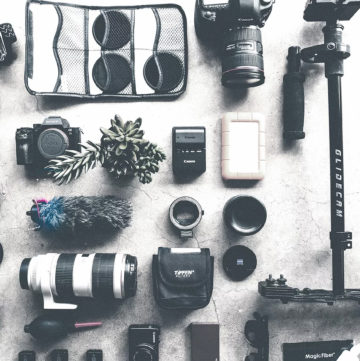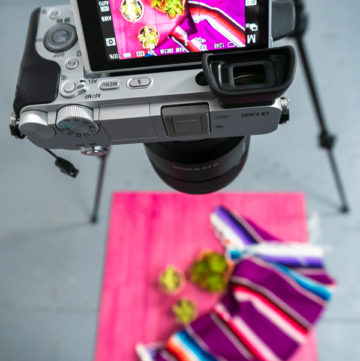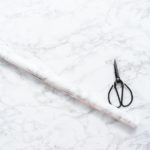How Much Does your Camera Really Cost to Own?
This post contains affiliate links.
Food Photography & Video Tips from My Studio
Here’s a peek at the tools, gear, and camera setups I use to film my recipe videos and photograph food at home. Over the years, I’ve tested dozens of different setups, and now I’m sharing what actually works for me—whether I’m filming overhead shots for YouTube or styling still photos for my blog. If you’re curious about how I create the content you see here, these posts are a great place to start.
With any expensive hobbies, it is easy to believe that better equipment will make you better at your hobby. Whether it be creating music, sports, or creating art, it is extremely easy to equate one’s skill to the value of one’s tools. However, after a bit, it’s just as easy to realize that one’s skill is a personal attribute and not the fault of one’s tools. This applies just as well to photography. When I first started my photography career, I started with cheap cameras and equipment, and I quickly purchased much more expensive equipment, as I thought doing this would improve my bad images, and help jumpstart my business.
Though my first camera served me well over the course of a couple of years, I had forgotten a very important aspect of cameras. Cameras are technology- and technology progresses very rapidly. After 4 years of buying and using the expensive Canon camera and equipment, I soon ran into several issues after not upgrading my equipment. Camera and lens technology advances so rapidly that it can be hard to keep up with, and waiting so long to upgrade my equipment created several other issues. My camera and lens setup weren’t advanced enough to keep up with the increasing production of videos instead of photos, and Canon also stopped supporting updates on my camera and other equipment. Soon after this, I was faced with a scary reality- I needed to upgrade all of my equipment, and quickly. This was especially hard since I had invested so much to buy the best equipment (at the time), which had quickly become obsolete and outdated. I also realized that my standards for camera equipment changed over time, and would be better fulfilled by Sony, so I both had to both upgrade and change brands of all my equipment. This move was especially painful since I had invested so much time and money into my Canon equipment, which eventually had no positive effect on my photography business.
After realizing this, I had to think a bit harder about what equipment to buy. I no longer looked only at price, but I had to pay attention to specifications, whether it’ll be beneficial for both videography and photography, whether the camera will work for everyday use, etc. Though I still considered the price of my equipment (especially my camera), I had to think a bit differently about the ‘cost’ of a camera. After being in the business for almost a decade and looking at all the available equipment, I began to realize that the cost of a camera is much different than the price tag.
Depreciation can range from 4% to 31% annually, depending on camera and brand. Camera depreciation rates are higher with low-cost cameras, and more expensive cameras depreciate much slower, and depreciation depends on the brand of camera.
A camera’s cost is also it’s value to the person behind it, it’s technological relevance, and it’s depreciation rate. A camera that specializes in videography would be worth far less in the hands of someone that has never shot a video before. This decreases the value of the camera, as it isn't being used to its fullest potential. Likewise, if you buy a piece of equipment and don’t use it, that piece of equipment becomes entirely worthless, as it isn’t being used to produce income. A cameras options are a big part of a camera’s price, so those also weigh in- if you won’t be needing those extra options, it’s best not to pay for them a camera’s technology is also a factor in its overall cost- if a camera is old, and does not produce images up to modern standards, its value will be far less than what it once was. This is where depreciation comes into play. A camera released 5 years ago at the best of its type will be extremely valuable at the time, but it would now be worth far less. The depreciation rate of anything can be easily calculated by subtracting its original cost by its resale/salvage value, divided by its useful life. For example, a Canon EOS 7D body costs $725 at retail value as of 2019 and can be sold for $259 with 26K shutter actuation (about half of the camera’s shutter life) over the course of 10 years, the camera loses around $46 of value every year. This formula is quite easy to remember and can be used to figure out the simple depreciation of anything.
Food Photography & Video Tips from My Studio
Here’s a peek at the tools, gear, and camera setups I use to film my recipe videos and photograph food at home. Over the years, I’ve tested dozens of different setups, and now I’m sharing what actually works for me—whether I’m filming overhead shots for YouTube or styling still photos for my blog. If you’re curious about how I create the content you see here, these posts are a great place to start.
However, knowing the real depreciation rate of a camera is not that simple, as many other factors come into play when figuring out the cost of owning a camera. First, it’s important to understand that cameras are a tool to make more money- if a camera is able to produce high-selling media and make as much or more money as it cost, then the cost of owning the camera will be negative, that is, you’re making a profit. If one was selling a camera after use over the course of several years was able to make back its original cost and then some, there is no cost of owning the camera. If the camera was rather ineffective and wasn’t able to make more than it cost, it has successfully depreciated, and salvaging the camera will be at a loss.
Of course, this depends on other variables such as one’s ability to produce demanded pieces of media and operate their business efficiently. Wear and tear is also an important thing to consider when figuring out a camera’s depreciation. If a camera that was left untouched with only a couple hundred shutter actuation is sold after a couple of years, it’s salvage price will be much higher than a camera that is well-used with many more actuation and wears under its belt, increasing depreciation of the camera. This same thing occurs to many other high-cost purchases, such as cars; as the saying goes, a new car loses 10% of its value as soon it is driven out of the dealership. The simple purchase of a camera will decrease its value, as those that re-sell cameras and consignment stores must offer the camera far cheaper than it’s the retail price in order to make money.
Consignment is a way to make back money on a purchased camera when it no longer fits your needs or you no longer need the camera after you’ve upgraded. This is the way I prefer to salvage my cameras, as I can often go to my local store and see if my old camera was sold and see if owning the camera cost me anything. Knowing the cost of owning a camera, not just buying it, is extremely important. Knowing this helps you make decisions that would be more beneficial for your business and how to run it cost-effectively. If you know that a specific brand or type of camera costs more to own than other cameras that are better suited to your needs, it’s best to understand the cost difference and make smarter and more cost-effective purchases.
To give a few examples, I’ve chosen a few models and brands of camera, their retail price, and their resale price. From this, we can figure just how much cameras depreciate over time. It’s important to understand that these cameras are not being judged by their performance, but rather their unique depreciation rates. Click on the links in the table to see listings and current prices for each camera*:
| Retail Price | Salvage Price | Useful Lifetime | Depreciation Rate (%) | $ Lost per Year | |
| Canon 5D Mark III | $2,385 | $1,638 | 7 Years | 4% | $106 |
| Sony A99 | $2,800 | $898 | 4 Years | 16% | $475.5 |
| Sony A6300 (w/ 18-135mm) | $1,148 | $1,009 | 1 Year | 12% | $139 |
| Nikon D7000 | $799 | $289 | 2 Years | 31% | $255 |
* These prices are all of 2019, in USD, and taken from my local camera store. These prices might vary from region and time.
From this, we can see some very interesting trends. Though we would have to look at many more cameras to make any concrete ideas on why depreciation rates vary, we can make a conclusion from this table. Camera depreciation rates are higher with low-cost cameras, and more expensive cameras depreciate much slower, and depreciation depends on the brand of camera. For example, Canon is the leading brand in high-end cameras in 2019, so their cameras will depreciate less than other brands since people are willing to pay more for higher-end used cameras. However, this is not static- Sony is quickly surpassing Canon in the market of cameras, which will create a different situation for the depreciation of cameras of both brands. It’s important to understand that this is not a static situation, and markets will always be fluctuating, so a camera’s depreciation rate is never set in stone. Knowing this, it’s important to make informed decisions on your next camera purchase, and knowing the annual cost of owning a camera.
Food Photography & Video Tips from My Studio
Here’s a peek at the tools, gear, and camera setups I use to film my recipe videos and photograph food at home. Over the years, I’ve tested dozens of different setups, and now I’m sharing what actually works for me—whether I’m filming overhead shots for YouTube or styling still photos for my blog. If you’re curious about how I create the content you see here, these posts are a great place to start.
#foodphotographer #foodphotography #camera #cameraequipment #stockphotography #stockfootage #foodphotoshoot #studioequipment #studiophotography #studiophoto #photostudio #photography #studiophotography #videography #photofilters #filters #ndfilters #plfilters



























Leave a Reply